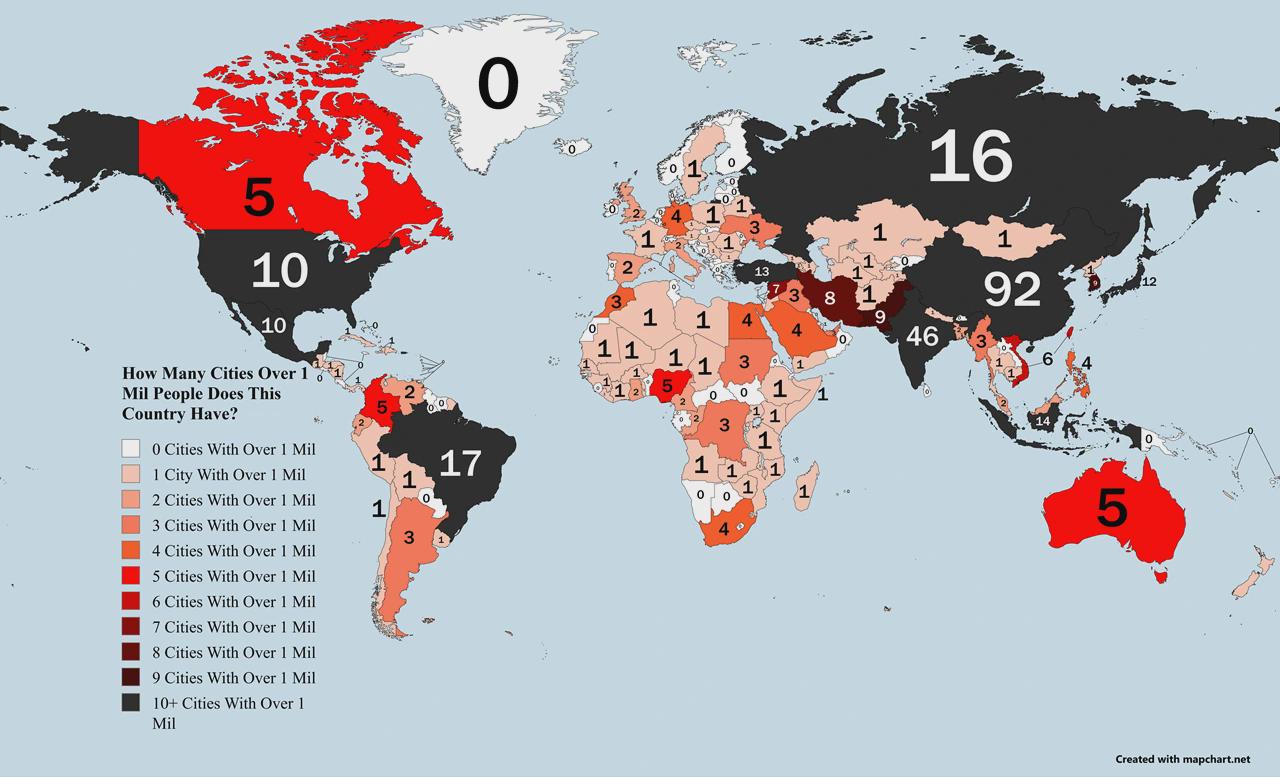Countries Ranked by Cities with 1M+ Population Map


Marcus Rodriguez
Historical Geography Expert
Marcus Rodriguez specializes in historical cartography and geographic data analysis. With a background in both history and geography, he brings unique...
Geographic Analysis
What This Map Shows
The visualization titled "Countries Ranked by Number of Cities with 1M+ Population Map" provides a clear representation of the countries around the world that boast the highest number of cities with populations exceeding one million. This map highlights the urban landscapes that are not only populous but also significant in terms of cultural, economic, and political influence. It serves as a fascinating lens through which we can examine urbanization trends, demographic shifts, and the global distribution of large urban centers.
Deep Dive into Urban Population Trends
Urbanization is a defining phenomenon of the 21st century, transforming the way we live and interact with each other. As of the latest data, there are over 500 cities globally with populations that exceed one million, and the distribution of these megacities offers critical insights into global population dynamics. The rise of urban areas is intricately linked to various factors, including economic opportunities, migration patterns, and social changes.
Interestingly, countries such as China, India, and the United States dominate this map. China, for instance, is home to an impressive number of cities with over one million residents, with giants like Shanghai, Beijing, and Guangzhou leading the pack. This rapid urbanization can be attributed to rural-to-urban migration, economic reforms, and significant investments in infrastructure. In fact, by 2030, it's projected that two-thirds of the world’s population will reside in urban areas, emphasizing the critical nature of understanding urban growth.
India follows closely with a growing number of cities like Mumbai, Delhi, and Bangalore, which are not only populous but also serve as economic hubs. The sheer scale of urbanization in India can be attributed to various factors, including population growth and economic development, presenting both opportunities and challenges for urban planners.
In contrast, the United States, with cities like New York, Los Angeles, and Chicago, showcases a different pattern of urbanization. Here, the growth of cities is often linked with historical migration trends, economic opportunities, and a unique suburban sprawl that shapes the American urban landscape.
Moreover, the emergence of cities with over one million residents in other regions, such as Brazil, Indonesia, and Nigeria, highlights the global nature of urbanization. These countries are increasingly becoming urbanized, driven by factors such as industrialization, globalization, and improved living standards.
The implications of these population trends are profound. High population densities in certain areas can lead to economic growth but also pose challenges such as congestion, pollution, and inadequate infrastructure. Planning for sustainable urban development is essential to ensure that cities can accommodate growing populations while maintaining quality of life.
Regional Analysis
Breaking down the map by regions reveals intriguing contrasts. In Asia, for example, the sheer number of megacities is staggering. Cities like Tokyo and Seoul not only have large populations but also serve as cultural and technological hubs of the world. They attract talent and investment, thus reinforcing their status as global cities.
In contrast, Africa is experiencing rapid growth in urban populations, with cities like Lagos and Cairo emerging as significant urban centers. However, these cities often face unique challenges, such as inadequate infrastructure and public services, making it essential to address these issues to harness their full potential.
Europe, while home to some populous cities like London and Paris, generally has a lower number of cities exceeding one million compared to Asia. This is due to a variety of factors, including historical urban development patterns and population density regulations. Interestingly, the European urban landscape is characterized more by smaller cities with high quality of life rather than a few sprawling megacities.
Significance and Impact
Understanding the distribution of cities with million-plus populations is not just an academic exercise; it has real-world implications. As urban areas grow, they become critical centers for economic activity, innovation, and cultural exchange. However, this growth also brings challenges such as housing shortages, environmental degradation, and social inequality.
Urban areas are often seen as engines of growth, and their health is vital for national and global economies. With rising urban populations, issues like public transportation, healthcare, and education become more pressing. Additionally, as cities grapple with climate change, the need for sustainable urban planning becomes ever more crucial.
In conclusion, the map of countries ranked by the number of cities with populations over one million sheds light on the urbanization trends shaping our world. As we look towards the future, understanding these dynamics will be essential for creating sustainable, resilient cities that can thrive in an increasingly urban world.
Visualization Details
- Published
- August 13, 2025
- Views
- 106
Comments
Loading comments...